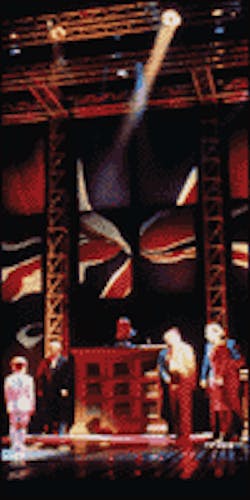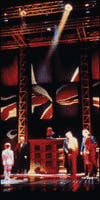Dichroic filters provide color stability
By John Fuller
Maintaining constant transmission even under very high temperatures, dichroic filters produce reliable color for stage, television, and film lighting.
Although dichroic filters have long been commonplace in technical industries, they were seldom used in entertainment lighting until about 20 years ago. It has always been the case that the residential and commercial lighting industries have sought more energy-efficient sources, while the entertainment lighting industry has sought brighter, color-balanced, more controllable, and often larger sources. With the introduction of automated fixtures in entertainment lighting in the early 1980swhich use small plasma-arc lamps and compact opticsentertainment lighting was finally ready for dichroic filters. Capable of maintaining consistent transmission under very high temperatures, dichroic filters met the needs of this new type of fixture. Now, automated lighting fixtures are a mainstay of most entertainment lighting systemsall of which use dichroic filters.
The common language of the scientific optics industry does not apply in entertainment lighting. A term such as "bandpass filter" may become "congo blue" or "color temperature orange." While entertainment lighting may be designed, developed, and backed by technically savvy individuals, often the ultimate decision of which filters are to be used is made by designers and visual artists. Entertainment lighting encompasses live stage performances as well as the creation of motion pictures and television showsareas that have both similarities and differences.
Lighting the stage
As used in entertainment lighting, color is one of the most powerful tools in creating mood (see photo, above). Originally, stage lights were colored using dyed gelatin (hence the common name "gel"), which was then cast into sheets. The functional life of gel sheets was very short. In the early 1970s, plastics gained widespread use and eventually found their way into entertainment lighting in the form of surface-coated polyester lighting filters. Organic dyesthe same used in making gelatin filterswere coated onto the surface of polyester film. Although still termed gel, the polyester base material significantly added to the serviceable life of filters and made them impervious to water damage.
To theatrical lighting designers, polyester filters were a great improvement. Hundreds of colors were available, most that could last through at least one showand usually manywithout melting or fading, and all at a relatively low cost. The theatrical designer now has more than 100 different blue tints alone to choose from, all off the shelf. But as fixture manufacturers began incorporating smaller, hotter lamps into increasingly sophisticated lighting fixtures, polyester-based filters could not survive the heat.
Television and film
In theatrical environments, the light is intended for viewing by the human eye, which is highly sensitive and flexible in its response. In television and film, however, the image must be captured either photoelectronically by cameras or photochemically by film, both unforgiving methods in comparison.
The term "white balance" describes the manipulation of the sensitivity of light and color receptors in either film emulsions or television cameras. Television cameras' color sensitivity must be adjusted to correspond to the light source in order to reproduce colors accurately for the viewer. Once the white balance is set in the camera, the same visual spectra must be reproduced to create "white" for the camera. Either way, "white" for video or film is established by means other than the human eye.
As a result, much of the effort in manipulating light for film and video is spent correcting the light spectrum with filters to create the proper spectral balance so that the film or video camera sees "white." The most common light sources for television and film are daylight (nominally 5500 K color temperature) and tungsten, or incandescent (nominally 3200 K). Corrections one way or the other (for example, daylight to tungsten) are often made. The studio parlance for corrections has evolved to CTB (color temperature blue) for daylight correction and CTO (color temperature orange) for tungsten correction.
The lighting fixtures used in making motion pictures are high-poweredsometimes as high as 10,000 W. Polyester filters are normally attached to 4-ft-square frames and placed a few feet from the front lens of the fixture to extend life by spreading the energy absorbed over a large area of filter.
Where dichroic filters are used
A glass dichroic filter weighs approximately 5.6 gm/in.2 and costs $3 per square inch, while a polyester filter weighs 0.08 gm/in.2 and costs a mere $0.01 per square inch. A dichroic filter has a melting point above 700°F, however, while a polyester filter melts at only 356°F.
So why would an entertainment lighting designer use anything but polyester? There is no simple answer. The popular automated fixtures' lamp types and size preclude the use of color filters other than dichroic; for these fixtures, there is no other choice. Designers of theme parks and long-running shows want design integritythat is, assurances their designs will last. These applications are the most obvious for dichroic filters.
FIGURE 1. Transmittance curves are shown for two blue-green or cyan filters (left), where LD-C04 is a dichroic filter and LP-C04 is a dyed polyester filter. In spite of subtle differences in the curves, the colors produced by these two filters appear almost exactly the same to the human eye. In contrast, dichroic LD-V47A and LD-V47B filters are compared with the dyed polyester filter LP-V47 (right). Based on the curves, the LD-V47A and LD-V47B would appear to be the most similar pair of the three. Under visual assessment, however, LD-V47A and LP-V47 are the closest visual match (LD-V47B visually presents a distinctly redder appearance).
Shopping malls and other public spaces increasingly seek to create a themed environment via theatrical effects. While not thought of in terms of entertainment, these spaces are popular venues for dichroic color filters. Almost unlimited color stability and high temperature resistance make dichroic filters well-suited for architectural applications (if filter fading is an issue, then the labor costs to maintain design integrity become prohibitive). The disadvantages to dichroics are cost and color halation (shift) at the beam edge of wide-beamed fixtures.
How to talk about filters
In entertainment lighting, the common nomenclature follows that of photographers and cinematographers. A CT (color temperature adjusting) filter modifies color temperature, producing "warming" and "cooling" effects. A CC (color compensating) filter reduces or eliminates color casts, and also warms or cools. An ND (neutral density) filter attenuates light with no color shift. A color-effect filter adds color to affect mood. Finally, a diffusion filter changes contrast and shadows.
One of the largest issues manufacturers of dichroic filters must contend with is the differences between the technical and lighting industriesin other words, how to reconcile technical requirements with creative ones in entertainment lighting. The ability of a cutoff filter to reduce transmission 50% at a given point in the visible range within ±5 nm has no relevance to a lighting designer.
First and foremost, the lighting designer must determine whether the color produced by a combination of light and filter is the artistically desired one. Because of the historic use of dye-based filtration, it is presumed that all filters intended for a particular use will match visuallya criterion that can sometimes be a challenge for dichroic filters. Batch-to-batch consistency is paramount.
Engineers at Lee Filters have long ago settled on using the CMC (Color Measurement Committee) formula derived from CIE (Commission International de L'Eclairage) values, which in turn come from the CIE xyY chromaticity diagram representing the vision of a standard observer.1 This formula best represents how the eye senses color, providing an approximate mathematical representation of visual acceptability. Mention CMC to a lighting designer, however, and you will be met with a blank stare. In the end, it is the suppliers and manufacturers who must understand the technical issues of measuring and reproducing color, and it is the designers who must use it.
REFERENCE
1. J. the Soc. Dyers and Colourists, 115 (May/June 1999).
JOHN FULLER is vice president of the Lee Filters division of Panavision Inc., 2237 North Hollywood Way, Burbank, CA 91505; email: [email protected].


